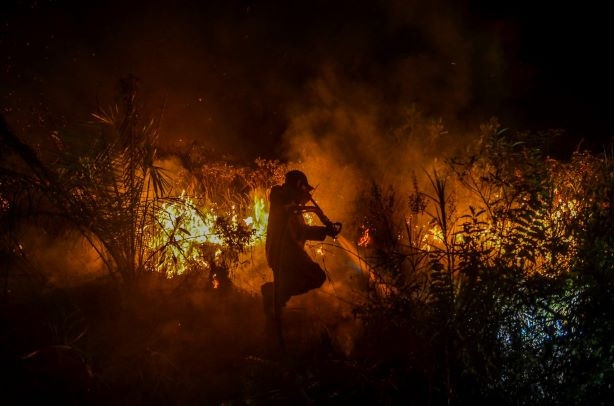Popular Reads
Top Results
Can't find what you're looking for?
View all search resultsPopular Reads
Top Results
Can't find what you're looking for?
View all search resultsThe specter of forest fires and haze
As fires know no boundaries, it is paramount that landscape activities integrate fire-free elements, with the support of various levels of government.
Change text size
Gift Premium Articles
to Anyone
O
ver the past few months the Meteorology, Climatology and Geophysics Agency (BMKG) has repeatedly warned about an extreme El Nino during this year’s dry season even to the point of raising the specter of the 2015-2016 forest and peatland fire crisis which, according to World Bank estimates, destroyed 2.6 million hectares in Sumatra and Kalimantan and caused US$16 billion in losses.
The National Food Agency responded well to the warning and alerted all stakeholders about the risk of food shortages due to poorer harvests. The government followed up with a contingency program to import 2 million tonnes of rice, the country’s staple food. Hence, skyrocketing rice prices will most likely be averted. However, central government agencies, regional administrations and plantation companies seem to taken the warning rather lightly, in so far as the risk of forest fires is concerned.
Mass media last week headlined reports on forest and peatland fires raging in Sumatra and Kalimantan and blanketing major cities on the two major islands in haze. Singapore and Malaysia have not yet complained about heavy smoke but it could simply be a matter of time before haze crosses international borders.
We doubt that the central government has acted firmly to gear up the Fire Free Alliance (FFA), a multi-stakeholder platform comprising forestry and agriculture companies, NGOs and other concerned collaborators and partners committed to resolving the country’s persistent haze issue arising from forest and land fires.
But it is not too late for the government to put the FFA members, including regional administrations, on full alert to prevent a forest and peatland fire crisis because several climate advisory reports have predicted that a strong El Nino will continue until late this year. Cooperation among all stakeholders is most imperative because the causes of forest and land fires during the dry season are multiple and complex. In the case of the risk of natural disasters amid the forecast extreme El Nino and the climate emergency, it is better to be overly prepared.
Past experience shows that forest fires during the dry season are usually caused by a combination of several factors: “Slash and burn” for subsistence farming, land clearing for plantations, underground peat fires and accidental fires related to daily habits of the people such as casual disposal of lit cigarette butts and untended cooking stoves. As fires know no boundaries, it is paramount that landscape activities integrate fire-free elements, with the support of various levels of government.
Regional administrations should closely watch whether palm oil firms, notably those in fire-prone peatland areas in Kalimantan, Riau and South Sumatra, have put their fire-prevention and management systems and their networks of fire-monitoring posts and fire towers and patrol vehicles on full alert. The companies’ fire-prevention systems will never be effective without good cooperation with local administrations and local people.
The role of the communities is paramount in preventing fires as they function as the eyes and boots on the ground, especially in areas inaccessible to companies’ firefighting teams. Local administrations and plantation firms should step up cooperation to empower the people around fire-prone areas through information campaigns and even firefighting training sessions to prevent fire.
The threat of wild forest and peatland fire again reminds us of the weak enforcement of the ASEAN Agreement on Transboundary Haze Pollution (AATHP) which was signed in Kuala Lumpur in June 2002 and has been ratified by six of the 10 ASEAN members to make it formal.
The agreement stipulates that ASEAN countries should undertake and carry out certain statutory obligations and one of the obligations is to take legislative, administrative and other measures. But Indonesia, which has often been blamed as the main source of haze due to the cyclical forest fires, has yet to enact a domestic transboundary haze pollution law. Neither has Malaysia.
Up to now, only Singapore has enacted domestic transboundary haze pollution law, which creates extra-territorial liability for entities engaging in setting fires abroad that cause transboundary smoke or haze pollution in Singapore.











